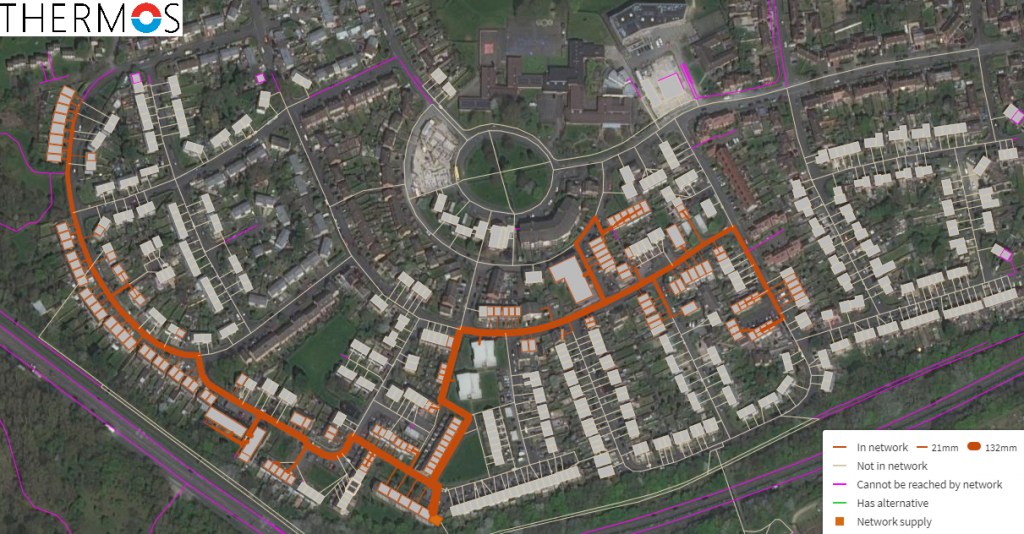To provide the best possible economic optimisation and evaluation of energy systems Carbon Alternatives uses a number of commercial modelling tools. These are:
energyPRO

‘energyPRO is the leading software for modelling and analyzing complex energy projects with combined supply of electricity and thermal energy (process heat, hot water and cooling)’
Ground Loop Design

‘the industry leading software for designing ground source heat pump systems’
THERMOS

THERMOS provides advanced energy system data and models in a user-friendly open-source software to make heat network planning faster, more efficient, and more cost effective.
Initially Martin used Excel to model the operation of heat networks with CHP and thermal stores operating to meet the estimated heat loads whilst trying to maximise the operation of the CHP at times of highest electricity value. This approach was limiting in the number of assumptions and approximations that had to be made and error prone as the Excel model was modified for each project to match the requirementsand available input data. On starting work at SSE, the opportunity was available to look at better modelling software and energyPRO was selected in 2007 and this is modelling tool that Martin has used ever since.
The benefits:
The use of variable time of day electricity tariffs leads to significant improvements in economic returns from heat pumps and CHP, and the opportunity maximised if the plant is designed for this from the outset. This leads to larger CHPs / heat pumps and larger thermal stores, but you can only assess the economics robustly if your model can model it. energyPRO can. Most heat network feasibility studies the Martin has reviewed use and single average price for power exported (for CHP) and power imported (heat pump). If you try and sell CHP generated power for a larger CHP you will be offered a tariff that varies with time of day, and so the use of a single average electricity doesn’t reflect reality and reduces possible return. For heat pump asking for a variable tariff will lead to different plant sizing and improved economic returns. But your model needs to be able model this and the resulting use of the thermal storage. energyPRO does in the same time as it would take to model on the basis of a flat electricity price. Martin has presented these optimization approaches for BEIS, as paper for the CIBSE Technical Symposium (both on the publication webpage) and the approach is incorporated into the CIBSE Heat Networks Code of Practice CP1 (2020). This approach was standard practice for Martin during his time at SSE to maximise the economic returns from heat network. This also increased the carbon savings.
In recent years the rapid decarbonisation of the electricity grid removes the carbon saving from CHP, and the focus has moved to heat pumps. The modelling of heat pumps is more challenging still as their efficiency changes materially with both source temperature and output temperature. The source temperature for ASHP changes constantly and river source will change daily, maximum annual heat pump performance will only be achieved it the heat network operates on a weather compensated variable temperature basis. This can all be accurately model, quickly, using energyPRO.
For ground source heat pumps horizontal loop and vertical borehole are expensive, but if the source temperature is to be close to the undisturbed ground temperature many boreholes are needed. The GLD software allows a much more robust estimation of the long-term ground loop operating temperatures and hence heat pump CoP.
Heat pump evaluations undertaken to date indicate the difference between ASHP CoP and those for GSHP or WSHP once all the temperatures pumping costs are accurately modelled. This attention to detail and best possible accuracy does influence the technology choice. Significantly is the large additional cost and risks of GSHP over ASHP worth the small CoP improvement?


energyPRO and GLD are expensive, but quickly deliver more accurate assessments and hence identify better option with more confidence than can otherwise be achieved.
Thermos – is currently a free on-line tool (but with quite an investment in time to under how it works). Thermos is powerful in its ability to assess optimum economic network size and is designed for use to rapidly identify area that warrant further analysis. With more bespoke / local data input Thermos provides a robust basis for optimising scheme sizes at the more detailed heat network assessment stages. Martin has undertaken the Thermos training.
